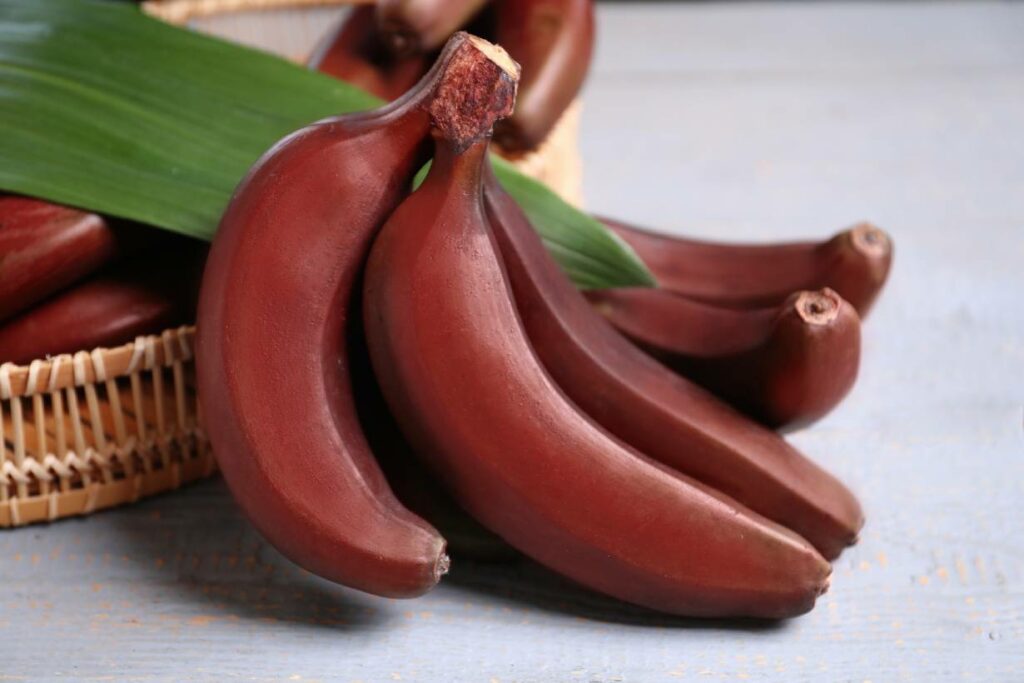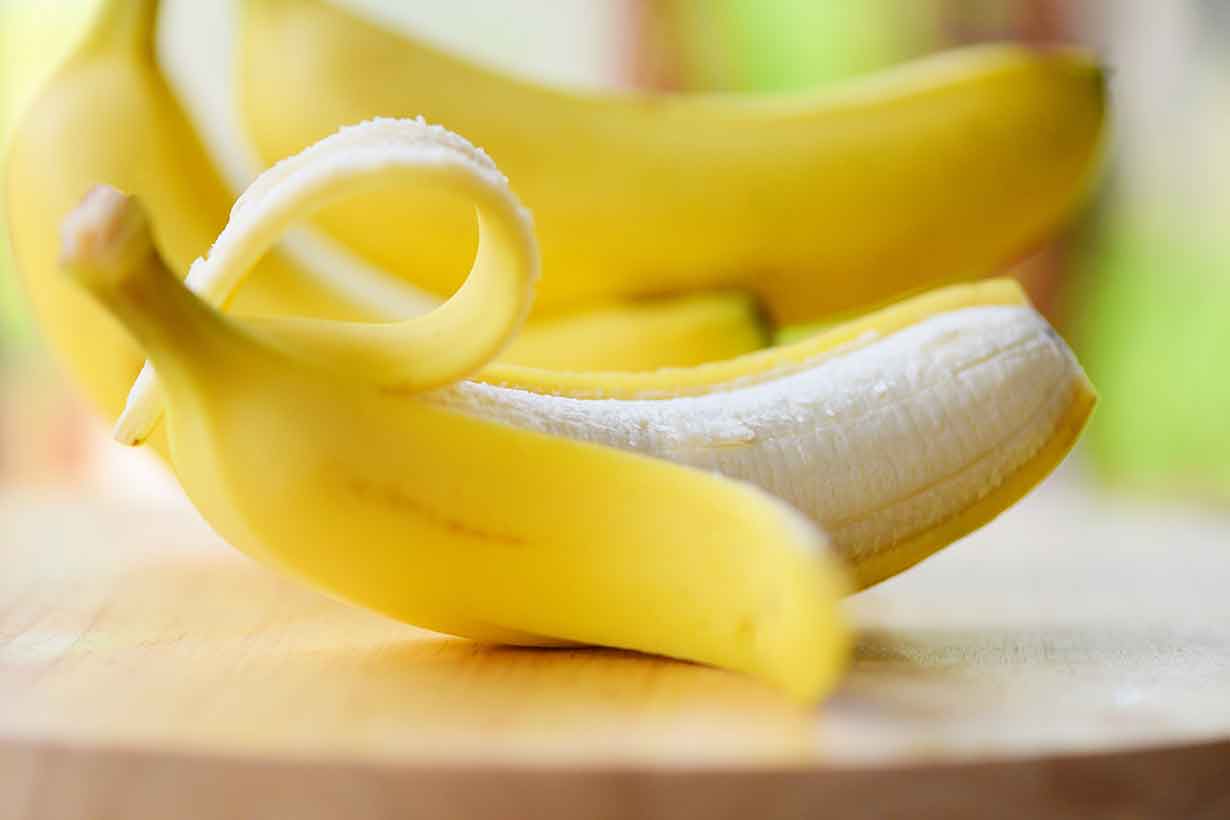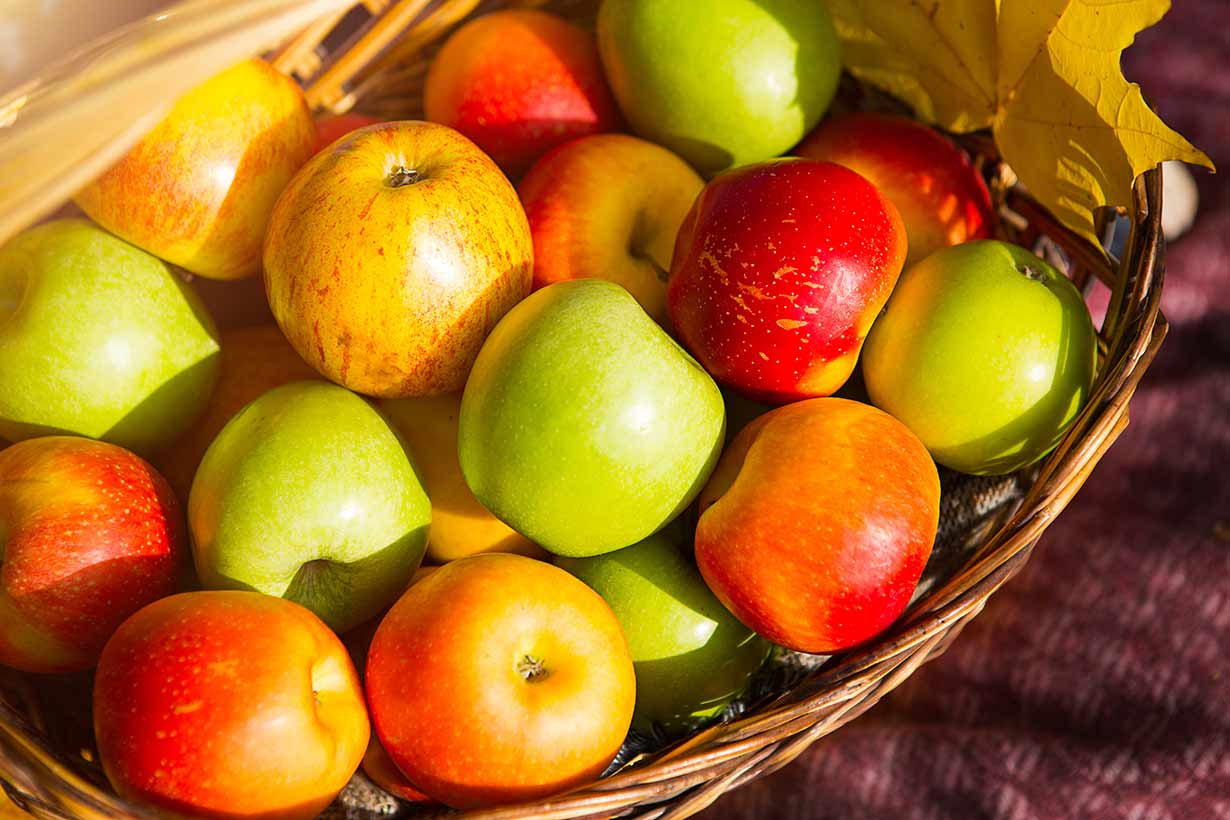Red bananas are a distinct variety of banana characterized by the red hue of their peel.
In this article, we delve into the characteristics of red bananas, explore how they differ from regular yellow bananas, and assess their nutritional properties.
What Are Red Bananas?

The red banana is a cultivar of the wild banana, scientifically known as Musa acuminate ‘Red Dacca’ (1).
In terms of appearance, taste, and nutritional profile, red bananas closely resemble the familiar yellow (Cavendish) bananas. However, there are notable distinctions between the two, which will be explored in more detail later in this article.
Despite their similarities, red bananas, like all bananas, are botanically classified as berries. This fact is not widely known, likely because bananas are not consumed in a way typical of common berries.
This botanical classification is due to the criteria that berries are fruits that containing seeds that originate from a single ovary. Interestingly, this places fruits such as bananas and avocados under the category of botanical berries (2).
Red bananas predominantly grow in tropical regions, with major production hubs located in South America and South and Southeast Asia (3).
How Does a Red Banana Taste?
Red bananas share a similar texture with regular yellow bananas. However, there are some subtle differences in taste.
People commonly describe the taste of a red banana as being slightly sweeter with hints of berry flavors.
How Do Red Bananas Differ From Yellow Bananas?
Now that we have an understanding of what red bananas are, let’s explore the key differences between them and common yellow bananas.
Color
The term ‘red banana’ may confuse some people as the banana’s flesh shares the same color as regular bananas.
However, as previously discussed, the peel of red bananas has a distinct reddish-maroon hue when fully ripe.
Similar to yellow bananas, the peel of a red banana undergoes changes throughout the ripening process, starting with a green peel when unripe.
As the banana ripens, the color will slowly change to a yellow and, after this, it will develop its characteristic red hue. As the banana develops its red color, it has a corresponding and progressive increase in sweetness and flavor.
Size
Similar to yellow bananas, red bananas come in a range of sizes.
This means a red banana could be larger or smaller than a yellow banana, depending on their respective sizes.
Anthocyanins
The red color of the banana’s peel is due to the presence and concentration of specific anthocyanins, a type of polyphenol.
Among these anthocyanins, four are present in red bananas but absent in yellow bananas. These anthocyanins include (4):
- Cyanidin 3-0-rutinoside
- Peonidin 3-rutinoside
- Rutinoside derivatives of petunidin
- Rutinoside derivatives of malvidin
Price and Availability
As of 2024, the global banana market is estimated to be worth $140.83 billion US dollars (4).
Using the above figure as a benchmark, the global red banana market is comparatively small, with a value of only $126.03 million in 2022 (5).
In other words, the red banana market is worth less than 0.1% of the total global banana market.
This smaller market size means it can be more challenging to find red bananas for sale. Due to the limited supply and market dynamics, red bananas often carry a notably more expensive price tag.
Nutritional Benefits of Red Bananas
Considering the similarities between the two, most of the nutritional benefits that red bananas offer also apply to yellow bananas.
However, the phytochemical content is one area where there are some distinctions between the two.
In the following sections, we will delve into the primary nutritional benefits of red bananas. Nutritional data will be presented on a per-100-gram basis, which is equivalent to a small red banana.
Red Bananas Are High In Potassium
Like all bananas, red bananas serve as a good source of dietary potassium.
Per 100-gram serving, red bananas typically supply 358 mg of potassium. This contribution represents 7.6% of the recommended daily value (% DV) for potassium, set at 4700 mg (6, 7).
Potassium plays a crucial role in maintaining normal blood pressure levels, and yet, a substantial proportion of the population fail to meet the recommended intake for this essential mineral. Notably, potassium has been designated as a ‘nutrient of concern’ in the 2020-2025 Dietary Guidelines for Americans (8, 9, 10).
Furthermore, a lack of dietary potassium and a low potassium-to-sodium ratio are associated with an increased risk of cardiovascular diseases. Incorporating more potassium-rich foods, such as red bananas, into the diet may help to lower blood pressure (11, 12).
Fiber
With 2.6 grams of fiber per 100 grams, red bananas present a moderate source of fiber (6).
Among its effects, fiber can contribute to lowering cholesterol levels, regulating blood sugar levels, and supporting overall digestive health (13, 14, 15, 16).
According to the FDA’s recommendation, based on a typical 2000-calorie diet, individuals are advised to consume a ‘daily value’ of 28 grams of fiber.
100 grams of red banana supplies just short of 10% of the daily value for fiber (6, 7).
Phytochemical and Antioxidant Content
As previously discussed in this article, the red banana derives its color from a high concentration of anthocyanin polyphenols (4).
Although banana peels are edible, they are not commonly consumed by many people. Therefore, when considering the phytochemical content of red bananas, it’s crucial to focus on the part most people eat: the flesh.
Interestingly, it does seem that red bananas may boast a higher total polyphenol content than their yellow counterparts.
To expand on this, a 2016 study conducted an analysis of the average polyphenol content in three different banana cultivars: two yellow banana varieties and red bananas (red dacca).
The findings indicated that red bananas exhibited the highest total polyphenol content, which was calculated in gallic acid equivalents (GAE). The red banana recorded a total phenol content of 1.07 mg GAE per gram, whereas the highest-ranking yellow banana variety had a total of 0.96 mg GAE per gram. There were no significant differences in vitamin C content between the three cultivars (17).
Furthermore, a 2021 study explored the antioxidant composition of flour derived from yellow and red bananas. In comparison to yellow banana flour, the flour made from red dacca bananas contained higher levels of polyphenols (18).
Dietary patterns rich in polyphenols are linked to various health benefits. In this regard, numerous large observational studies have identified a lower risk of call-cause mortality in individuals with a higher intake of polyphenols (19, 20, 21).
Red Bananas Are Nutrient-Rich Yet Relatively Low In Calories
Another positive aspect of red bananas is their ability to provide a broad range of beneficial nutrients for comparatively few calories.
For instance, a 100-gram serving of red banana typically provides (6, 7):
- 89 calories
- 2.6 grams of fiber
- 22% DV for vitamin B6
- 12% DV for manganese
- 10% DV for vitamin C
- 8% DV for potassium
- 6% DV for magnesium
- 5% DV for folate
How Can We Use Red Bananas?
Since there’s minimal difference in taste between red and yellow bananas, people typically consume them in similar ways.
Some common ways to enjoy red bananas include:
- Snack: Eating red bananas on their own as a snack.
- Fruit salad: Slicing red bananas and incorporating them into a fruit salad.
- Smoothies: Blending red bananas into smoothies.
- Porridge and cereal: Using sliced red bananas as a topping for porridge or mixing them into a bowl of cereal.
- Yogurt: Mixing sliced red bananas into yogurts, possibly alongside some nuts for added healthy fats, vitamins, and minerals.
- Baked goods: Using mashed red bananas to flavor various baked goods, such as bread, cakes, cookies, and pancake batter.
- Grilled red banana: Cutting the banana in half, adding seasonings of choice (such as cinnamon or nutmeg), and grilling the halves for two minutes on each side at medium heat.
Where To Buy Red Bananas
As mentioned earlier in this article, the global red banana trade constitutes less than 0.1% of the global banana market. Consequently, supply is limited, and red bananas are more challenging to find for commercial sale.
However, it may be possible to find them for sale at several locations, including:
- Specialty grocery stores that offer imported fruit
- Exotic fruit stores
- Larger grocery stores and supermarkets
- Asian grocery stores
- A quick online search for “buy red bananas” followed by your state or region, which should highlight some businesses selling red bananas
Final Thoughts
While red bananas don’t differ significantly from common yellow bananas, they do seem to contain slightly higher levels of polyphenols.
Beyond this, red bananas are a valuable source of essential vitamins and minerals.
Due to their slightly different taste and visual appearance, trying red bananas can be a unique experience. However, they don’t offer distinctive benefits and are generally similar to yellow bananas.








